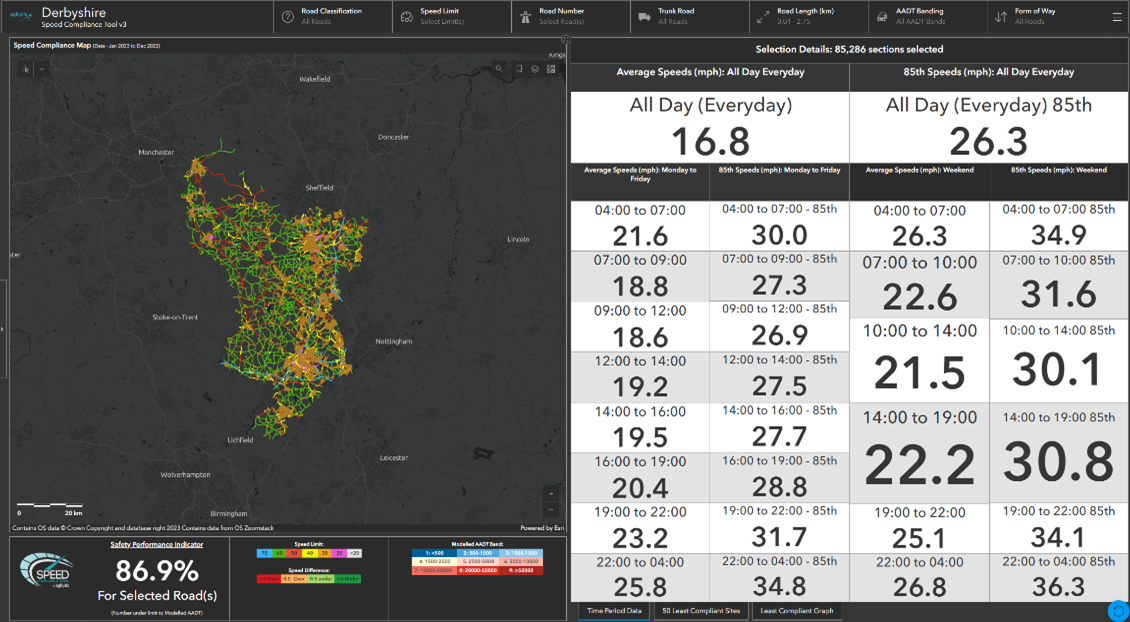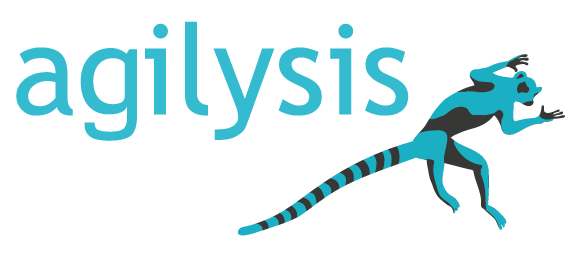
With five years of development history our Speed Compliance Tool (SCT) is proving to be a popular tool amongst road safety professionals from dozens of areas. It provides engineers, police officers and road safety professionals access to all day average and 85th percentile speeds for every road in their region. Not only that, alongside all day speeds it provides speed data by individual time periods throughout the working week and weekends on busier roads. It offers a map of speed limits, a digital record that many a TRO Officer would be envious of, and visualisation of modelled annual traffic volumes on all roads. Creating network coverage like this by traditional traffic data capture methods could cost £0,000s in survey equipment and time spent by the roadside.
Like all tools we must keep it up to date with data and technology changes and as its caretaker we must listen to user’s feedback to ensure it continues to fulfil its potential.
Last year we embarked on what has turned out to be a significant exercise to develop version 3 (v3) of the tool.
But why did we give ourselves this challenge?
Back in 2022 we rolled out version 2 to a small number of users and quickly it grew in popularity. Like any product that is exposed to more people with ideas and thoughts of their own, that meant we got more feedback on how the tool could be improved further.
At the same time Ordnance Survey (OS) announced changes they were making to the raw dataset to; increase time periods, switch from financial to calendar year data and provide data for 6-monthly date ranges.
We then saw an opportunity to streamline our data processing methodology to speed up future updates, and to top it off we became pioneers for a new reporting tool created by Esri UK!
So, what did we do?
There are many ways to approach product development, we opted for the 'waterfall' methodology to systematically identify requirements, design and develop the new tool, test it, before finally deploying the new version.
So metaphorically standing at the precipice of the waterfall edge we started by reviewing and considering the many comments and ideas collated from our users, as well as some we'd suggested ourselves, to identify those that we thought we could deliver and those that would be lodged behind a rock never to make the fall/cut!
At this early stage in the development process, we realised there was potential for v3 to involve some more substantial changes compared to the transition from version 1 to version 2. To supplement the feedback we already had we decided to canvas users specifically on their thoughts about particular features of the existing tool, which did they use most and any features they'd tended not to use. We also took this opportunity to share with user’s snippets of the data changes coming forward to check that our thoughts on including them all matched those of our customers.
The results from the survey offered us the insight we needed to conclude the first stage of the development cycle and understand the future requirements of v3.
Now we could take the step over the edge of our waterfall and dive into the design stage.
The Speed Compliance Tool is hosted on the Esri platform, and similar to us they deliver updates and improvements to their tools on a continuous cycle. Some of these feed straight into our tool, like the changes to the search tools users encountered last year, while others are new products.
Members of our team first saw Report Builder demonstrated at the annual Esri conference and quickly realised the opportunities it offered. So we embarked on a trial licence to explore its functionality and try applying it to our use case. The results were promising and after further conversations with Esri product developers we had a report template to test.
Meanwhile we'd also been busy designing a new front end for the SCT. Taking on board the comments shared by clients, at User Groups and through the survey, we removed features users didn't like, we tweaked some elements to make them more user-friendly and added other features that users were calling for.
By spring 2024 we had an Alpha version of SCT v3 to work from.
We reached out to a small number of our clients to help us with user testing. Thankfully they all agreed, and we shared with them the Alpha version. Again, our clients delivered and offered invaluable feedback – both positive and negative on the changes we’d made. They also sent us away with another list of ideas! This development stage felt rather like we’d landed in the plunge pool, coming up for air every so often before disappearing back under the bubbles!
What emerged was our SCT v3 Beta version.
In addition to changes to the front end design, our Technology team had been busy populating and building our new data warehouse using new format datasets from OS and Basemap.
The speed data used in SCT relies on data from two different sources which must be not only matched to one another but also matched to the road network. In addition, with the recent changes by OS, datasets must now be combined and 12-month average speeds and counts calculated. Finally, our pioneering statistical approach using individual vehicle counts and official DfT count point surveys to fit a Bayesian model & produce modelled Annual Average Daily Traffic (AADT) values for each road segment is the last piece in the data jigsaw.
One might think the task of matching spatial data to an ever changing network, of combining 6-monthly datasets, of modelling flow for individual road links from a sub-sample of traffic is straightforward. However, the complexity and idiosyncrasies of PostgreSQL multiplied by the task of doing this for millions of road segments covering the entire UK road network can feel like a whirlpool at the edges of the plungepool.
Application of the data to the dashboard was an instrumental stage in the quality assurance of the Beta version. Maintaining user input in the development of v3, a small number of existing clients were also invited to test the Beta tool. After some further adjustments, SCT v3 was finally signed off by our internal project team and sounds of the waterfall’s tumbling waters were beginning to soften.
With an approved product we could now embark on updating our supporting documents, ensuring customers have key information on the data and ready-to-hand assistance on how get the best from the tool. Having fully tested the draft we could also finalise the report template continuing the high quality of our outputs across all mediums.
The penultimate stage of our development cycle is now underway with deployment of SCT version 3 to our users up and down the country. So far feedback is very positive;
“version 3 knocks socks off version 2.” (Stephen Hughes, Derbyshire Police)
We hope this continues as more of our users come onboard. We look forward to traversing the smooth, calm waters downstream in the last of the development stages - maintaining the tool and supporting our existing and new clients in their use of SCT v3... until the next round of development!
That development cycle may wait a little while yet though. With all of the learnings we have made from this development we have plans up our sleeves for some of our other popular products such as CrashMap, RiskMap and V4.

Suzanne Coles, Principal Consultant






